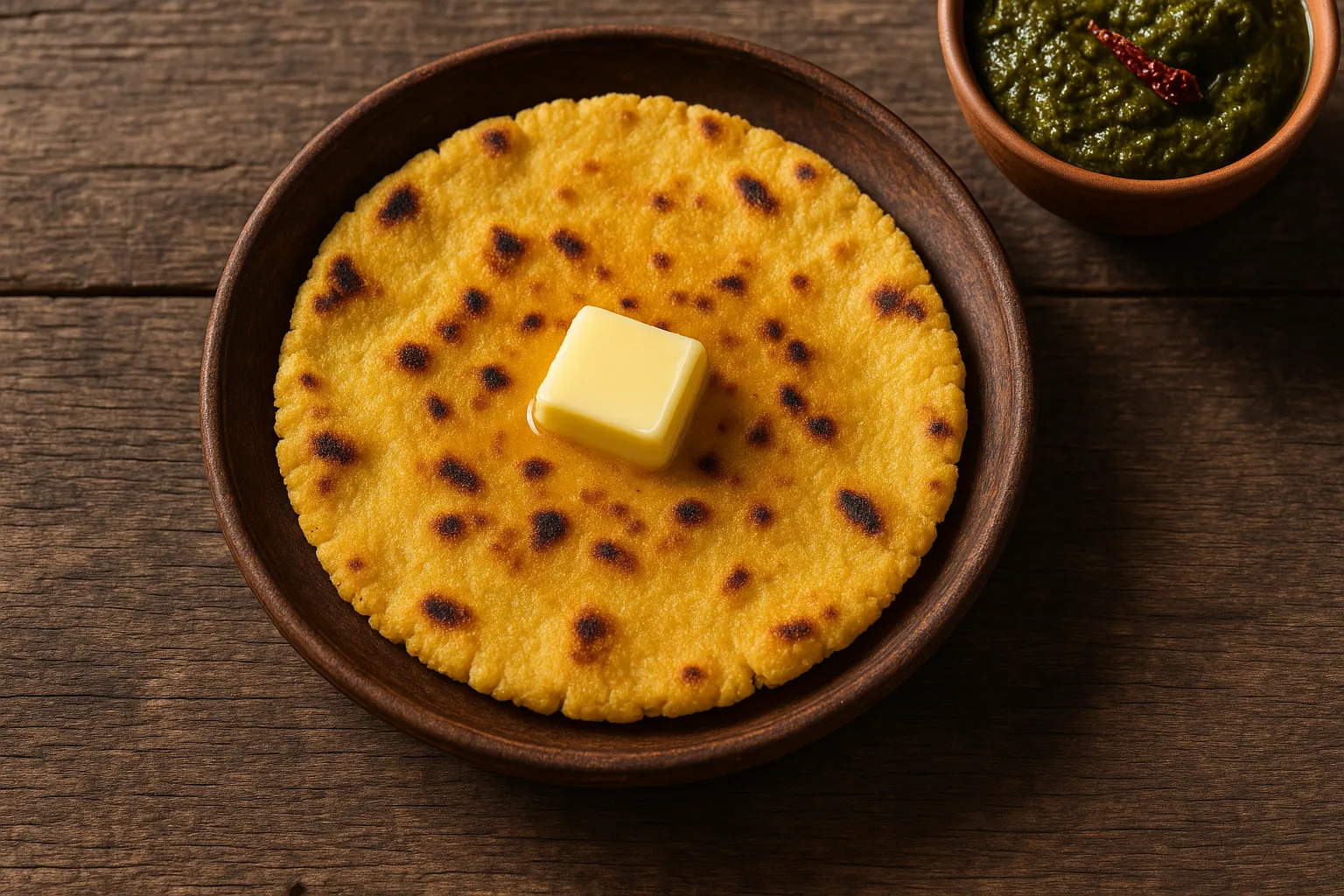Makke Ki Roti: Calories, Nutrition and Health Benefits
A traditional Punjabi gluten-free flatbread made from corn flour, cherished for its rustic flavor, warming properties, and balanced nutrition.
Quick Nutrition Facts
Per 1 Medium Roti (60g)
| Nutrient | Amount |
|---|---|
| Calories | 120 kcal |
| Protein | 2.8g |
| Carbohydrates | 24g |
| Fiber | 2.4g |
| Sugars | 0.8g |
| Fat | 1.5g |
| Magnesium | 28mg |
| Phosphorus | 65mg |
| Iron | 0.6mg |
| Vitamin B6 | 0.1mg |
Macronutrient Breakdown

NUTRITIONIST INSIGHT
Makke ki roti is a nutritional powerhouse. The corn flour provides sustained energy with lower glycemic impact than refined wheat. Rich in antioxidants like lutein and zeaxanthin for eye health, it's naturally gluten-free and perfect for winter nutrition when paired with sarson ka saag.
Myth Busters
MYTH #1: Makke Ki Roti is Too Heavy for Weight Loss
TRUTH: One makke ki roti has only 120 calories. The 2.4g fiber promotes fullness and aids digestion. It's portion size that matters - limit to 2 rotis per meal with vegetables, not the roti itself that causes weight gain.
MYTH #2: All Corn Products Are High in Sugar
TRUTH: Makke ki roti contains only 0.8g natural sugars per roti. Unlike processed corn products (corn syrup, cornflakes), whole corn flour maintains its fiber and nutrients. The complex carbs digest slowly, providing steady energy without blood sugar spikes.
MYTH #3: Gluten-Free Foods Have No Nutritional Value
TRUTH: Makke ki roti is naturally gluten-free and nutrient-dense with fiber, magnesium, phosphorus, and B vitamins. It offers antioxidants (lutein, zeaxanthin) not found in wheat roti. Excellent alternative for celiac disease and gluten sensitivity.
MYTH #4: Only Wheat Roti is Healthy
TRUTH: Makke ki roti provides unique benefits - more fiber than wheat roti (2.4g vs 2g), gluten-free option, antioxidants for eye health, and warming properties for winter nutrition. Both have their place in a balanced diet.
NutriScore by Health Goals
| Health Goal | NutriScore | Why This Score? |
|---|---|---|
| Weight Loss |  | 120 calories per roti, 2.4g fiber promotes fullness. Limit to 2 rotis per meal, pair with low-calorie saag. |
| Muscle Gain |  | Good carb source (24g) for energy but lower protein (2.8g). Pair with high-protein paneer or dal for muscle building. |
| Diabetes Management |  | Lower GI (68) than wheat roti (72). Fiber slows glucose absorption. Limit to 1-2 rotis, pair with protein-rich saag or dal. |
| PCOS Management |  | Complex carbs with fiber support insulin sensitivity better than refined grains. Limit to 1-2 rotis, pair with vegetables and healthy fats. |
| Pregnancy Nutrition |  | Gluten-free option safe for pregnancy, provides energy, folate precursors, and B vitamins. Safe complex carbs. |
| Viral/Flu Recovery |  | Easy to digest, provides warmth and sustained energy. Ayurveda recommends for winter recovery. Gentle on stomach, supports immunity. |
PERSONALIZED NUTRITION
Track your meals with NutriScan for personalized NutriScores based on your specific health goals!
Blood Sugar Response to Makke Ki Roti
Understanding how makke ki roti affects blood glucose helps with portion control and meal pairing for stable energy.
Typical Glucose Response Curve
*This chart shows typical blood glucose response for general healthy individuals. Individual responses may vary. Not medical advice.*
How to Flatten the Spike
Pairing makke ki roti with protein and vegetables significantly reduces blood sugar impact:
- 🥬 Sarson ka saag (mustard greens) - Traditional pairing adds protein, fiber, and vitamins
- 🧈 White butter or ghee (1 tsp) - Healthy fats slow carb absorption
- 🥘 Dal makhani or rajma - Complete protein balances the meal
- 🥛 Buttermilk or lassi - Probiotics and protein aid digestion
This classic combination provides complete nutrition with minimal glucose spike.
Cultural Significance
Makke ki roti is deeply woven into Punjab's agricultural heritage and winter food traditions.
In India:
- Iconic Punjabi winter dish, traditionally paired with sarson ka saag and white butter
- Harvest celebration food during Lohri festival (January)
- Made fresh daily in rural Punjab using traditional stone grinders
- Represents agricultural abundance - corn harvested in autumn, eaten through winter
- Ayurveda classifies it as warming food (ushna virya) perfect for cold months
Regional Variations:
- Punjab: Thick rotis served with saag and jaggery
- Rajasthan: Thinner rotis paired with bajra roti
- Himachal Pradesh: Made with local corn varieties, served with chutney
- Nepal: Similar rotis called "makai ko roti" eaten with vegetable curries
Sustainability:
- Corn grows easily in Indian climate with minimal water
- Entire corn plant used: grain for food, stalks for animal fodder
- Traditional stone grinding preserves nutrients better than industrial processing
Compare & Substitute
Makke Ki Roti vs Other Indian Breads (Per 60g roti)
| Nutrient | 🌽 Makke Ki Roti | 🌾 Wheat Roti | 🌾 Bajra Roti | 🌾 Jowar Roti |
|---|---|---|---|---|
| Calories | 120 kcal | 110 kcal | 115 kcal | 118 kcal |
| Carbs | 24g | 22g | 23g | 24g |
| Fiber | 2.4g | 2g | 3g | 2.8g |
| Protein | 2.8g | 3.1g | 2.9g | 2.7g |
| Fat | 1.5g | 1.2g | 1.4g | 1.3g |
| Gluten | No | Yes | No | No |
| GI | 68 | 72 | 55 | 62 |
| Best For | Winter warmth, gluten-free | Daily meals, protein | Diabetes, high fiber | Summer cooling, digestion |
Frequently Asked Questions
Is makke ki roti good for weight loss?
Yes, makke ki roti supports weight loss when portion-controlled. One roti has only 120 calories with 2.4g fiber that promotes fullness and aids digestion. The complex carbs from corn provide sustained energy without causing rapid blood sugar spikes.
Weight loss tips: Limit to 2 rotis per meal; pair with low-calorie sarson ka saag or mixed vegetable curry; use minimal butter (1 tsp); eat for lunch rather than dinner; avoid deep-fried accompaniments.
Can diabetics eat makke ki roti?
Yes, diabetics can eat makke ki roti - it has a glycemic index of 68, which is lower than whole wheat roti (GI 72). The fiber content helps slow glucose absorption.
Diabetes management tips: Limit to 1-2 rotis per meal; pair with protein-rich sarson ka saag, dal, or paneer; add healthy fats (1 tsp ghee) to further slow carb absorption; best eaten for lunch; monitor blood sugar 2 hours after eating; choose fresh over stored rotis.
The complex carbs digest slowly, providing stable energy without dramatic blood sugar fluctuations. Always consult your healthcare provider.
Is makke ki roti gluten-free?
Yes, makke ki roti is 100% naturally gluten-free as it's made from corn flour (maize), not wheat. Perfect for people with celiac disease, gluten sensitivity, or those following a gluten-free diet.
Important: Ensure no wheat flour is mixed during preparation, which sometimes happens in restaurants to improve texture. For strict gluten-free needs, make at home with pure corn flour or verify restaurant preparation methods.
What are the main health benefits of makke ki roti?
Key Benefits:
- Digestive Health: 2.4g fiber per roti supports regular bowel movements and gut health
- Eye Health: Rich in lutein and zeaxanthin antioxidants protecting against age-related vision loss
- Gluten-Free Nutrition: Safe alternative for celiac disease and gluten intolerance
- Heart Health: Magnesium (28mg) and phosphorus support cardiovascular function
- Sustained Energy: Complex carbs provide steady energy without crashes
- Winter Warming: Ayurvedic warming properties perfect for cold months
Why is makke ki roti eaten in winter?
Makke ki roti is traditionally eaten in winter for several nutritional and cultural reasons:
Ayurvedic Perspective: Corn is classified as "ushna virya" (heat-producing), helping maintain body warmth during cold months. Aids metabolism and digestion in winter.
Seasonal Harvest: Corn is harvested in autumn (October-November), making it freshly available through winter months.
Nutritional Warmth: The complex carbs provide sustained energy and warmth. Paired with sarson ka saag (winter mustard greens), it's a complete seasonal meal.
Agricultural Tradition: Celebrates harvest with Lohri festival, honoring the corn crop that sustains communities through winter.
Is makke ki roti healthier than wheat roti?
Both have unique benefits - choose based on your health goals:
Makke Ki Roti Advantages:
- Higher fiber (2.4g vs 2g)
- Gluten-free option
- Antioxidants for eye health (lutein, zeaxanthin)
- Lower glycemic index (68 vs 72)
- Warming properties for winter
Wheat Roti Advantages:
- Slightly higher protein (3.1g vs 2.8g)
- Easier to roll and handle
- More readily available
- Neutral temperature properties
Recommendation: Alternate between both for dietary variety. Choose makke ki roti for gluten-free needs, diabetes management, or winter nutrition. Choose wheat roti for daily convenience and slightly higher protein.
Track with NutriScan app to see how each fits your personal nutrition goals.
How many makke ki rotis should I eat?
General Guidelines:
- 2 rotis per meal - Most adults (240 calories, balanced nutrition)
- 1-2 rotis - Weight loss, diabetes management
- 2-3 rotis - High energy needs, athletes, manual labor
- 1 roti - Strict calorie control, low-carb diets
Avoid excess: More than 3 per meal can provide excess carbs and calories. Balance with protein-rich accompaniments (saag, dal, paneer) and vegetables.


 ChatGPT
ChatGPT  Claude
Claude  AI Mode
AI Mode  Perplexity
Perplexity 



